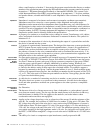144 Handbook of Intercom Systems Engineering
Peak
The crest value of a voltage, current, or power.
Phantom Power
There are three standard voltages: 12, 24, and 48, according to DIN 45 596. Voltage is applied to
the circuit in a balanced fashion using a center tapped transformer or two resistors. The size of the
resistors depend on the voltage.
Phase, Phase
Shift
Comparing the reference of one waveform to the reference point of another waveform. With
periodic waveforms, the phase varies from 0 degrees (waveforms line up), to 180 degrees
(waveforms opposite), to 360 degrees (waveforms line up but one is delayed by the time of one
waveform).
Pi (π)
Symbol for the quantity 3.14159...
Pickup Pattern
Refers to the sensitivity of a microphone to acoustic audio signals originating from different
spatial directions.
Pink Noise
Equal noise energy per octave.
PL
See Conference Intercom Systems.
PLL
Phase Lock Loop. A tone decoder utilizing a phase lock loop is used in many of the TW System
stations.
Point-to-Point
(Matrix)
Systems
A point-to-point system allows two or more people to intercommunicate. But the conversations
are limited to those selected by the originator of the call. This system normally includes a “tally”
subsystem. The “tally” subsystem tells the called station where the originator is so that the called
station operator can press a button to answer. Some systems automatically press the button and
complete the return path. Most systems made by RTS™ Systems are full duplex (one can
interrupt the speaker), and non- blocking (access to the channel is immediate and there is no busy
signal). Conversations on point-to-point systems are in general, private. There are two kinds of
point-to-point systems available. One is a distributed matrix system; the other is a central matrix
system. The Models 848A and DC848 are modules in a distributed matrix system. The McCurdy
Models 9500 and 9400 are examples of central matrix system.
Pop
An undesired effect on a microphone output when a puff of air hits the microphone diaphragm.
The effect sounds like a thump or pop. The effect is noticed with the following sounds: “p”, “b”,
“t”.
Pop Filter
Material placed between a sound source and a microphone that reduces the “pop” effects. It
slightly affects microphone performance.
Port
Ports are the individual channels that devices are connected to. Devices include: 2-way
communication devices, such as keypanels, belt packs etc. Audio sources, such as broadcast feeds
or background music. Miscellaneous audio output devices, such as powered loudspeakers, PA
systems etc.
Port Gains
RTS™ Keypanels are calibrated to send and receive audio at the standard operating levels of the
intercom system. No audio gain adjustment is normally required when connecting these.
However, many other types of devices may not operate at the standard intercom system levels. To
assure signal level compatibility between the various types of audio devices connected to the
intercom system, there are separate analog input and output gain adjustments for each intercom
port. It is also possible to adjust the listen gain for any specific intercom port when listening to
any other specific intercom port. This is called the point-to-point listen gain, or crosspoint gain.
For example, a keypanel operator might want to monitor a music source connected at some
intercom port, but at a reduced audio level so that it does not interfere with normal intercom
communications. The crosspoint gain can be reduced for the keypanel port listening to the port
where the music source is connected.Analog gain adjustment is only available using AZ™EDIT.
Crosspoint gains can be adjusted either within AZ™EDIT or from a programmable keypanel. For
further information on any gain adjustment in AZ™EDIT, search for keyword “gain” in
AZ™EDIT help. For procedures to adjust gain from a programmable keypanel, look for “gain” in
the manual index.
Port ID Numbers
and Alphas
Intercom ports have identification numbers 001, 002 etc. These numbers cannot be changed, but
may not be commonly known to intercom system users. Each intercom port also has a default
name, called an “alpha”, because this name appears in the alphanumeric displays on keypanels
when you assign the ports to keys for talking and listening. The default alpha names are N001,
N002 etc. These default alpha names can be changed to ones that are meaningful to keypanel


















